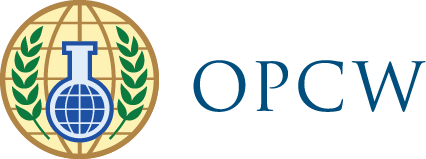History was made on 29 April 1997 with the entry into force of the Chemical Weapons Convention (CWC)—the world’s first multilateral disarmament agreement to provide for the elimination of an entire category of weapons of mass destruction within a fixed time frame.
The event marked both the culmination of many years of painstaking negotiations in the Conference on Disarmament and Preparatory Commission as well as the birth of an international chemical weapons disarmament regime headed by the Organisation for the Prohibition of Chemical Weapons (OPCW).
The OPCW strives to fulfil the Convention’s mandate to end the development, production, stockpiling, transfer and use of chemical weapons; to prevent their re-emergence; to ensure the elimination of existing stocks of such weapons; and, in so doing, to make the world safe from the threat of chemical warfare.
The Preparatory Commission
In 1993, Signatory States in Paris knew that a considerable amount of groundwork needed to be done before an international organisation capable of implementing the Chemical Weapons Convention could be established. Fortunately, the Convention provided that its entry into force was to occur at least two years after being opened for signature and only after 180 days had elapsed from the deposit of the 65th instrument of ratification. This left open a period of time in which such preparations could be made. In what was called the Paris Resolution, the Signatory States decided to set up a Preparatory Commission (PrepCom) with a mandate to make the necessary preparations for the first Conference of the States Parties and to continue work on issues that remained unresolved by the Convention’s negotiators. The PrepCom held its first Plenary Session in The Hague in February 1993 and established a Provisional Technical Secretariat.
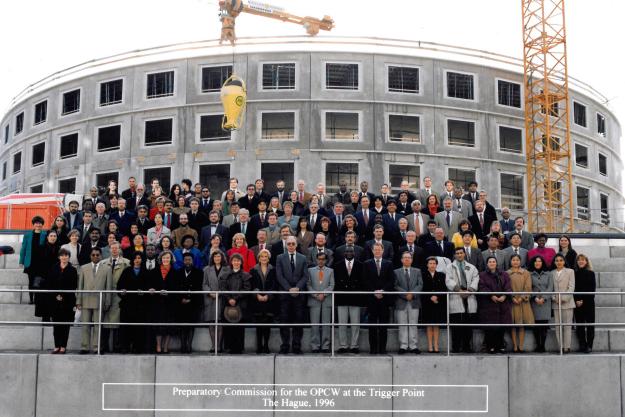
Trigger Point
When Hungary deposited the 65th instrument of ratification, it triggered the 180-day countdown to entry into force of the Chemical Weapons Convention.
The date of entry into force of the Convention was not determined until 31 October 1996, when Hungary became the 65th state to ratify. As required, the Convention entered into force 180 days later, on 29 April 1997. During the previous four years, the PrepCom met 16 times, laying the foundation for the workings of the future Organisation.
The PrepCom was successful in resolving a number of tasks within its mandate, the results of which were reflected in its Final Report. Among its major achievements were solutions to several substantive verification issues as well as the setting up of the OPCW Laboratory and Equipment Store, the development of a general training scheme for inspectors and the recruitment of inspector trainees, arrangements relating to the new OPCW headquarters building, and the development of draft documents, such as the Headquarters Agreement, the Staff and Financial Regulations, the Health and Safety Policy and Regulations, the Policy on Confidentiality, and the Media and Public Affairs Policy. The PrepCom was also responsible for the transfer of its property, functions and recommendations to the OPCW.
Past Chemical Disarmament Efforts
Although toxic chemicals had been used as tools of war for thousands of years, with the use of techniques such as poisoned arrows, arsenic smoke, or noxious fumes, their use was long stigmatised by an association with both unnecessary cruelty and unfair play, something beneath the standards of ‘civilised’ battle. Because of this, international efforts to ban chemical weapons took a prominent position in many early disarmament agreements.
The first international agreement limiting the use of chemical weapons dates back to 1675, when France and Germany came to an agreement, signed in Strasbourg, prohibiting the use of poison bullets. Almost exactly 200 years later, in 1874, the next agreement of this sort was concluded: the Brussels Convention on the Law and Customs of War. The Brussels Convention prohibited the employment of poison or poisoned weapons, and the use of arms, projectiles or material to cause unnecessary suffering, although the agreement never entered into force.
Before the turn of the nineteenth century, a third agreement came into being. The chemical disarmament efforts of the twentieth century were rooted in the 1899 Hague Peace Conference. The contracting parties to the 1899 Hague Convention declared their agreement to ‘abstain from the use of projectiles, the sole object of which is the diffusion of asphyxiating or deleterious gases’. A second Hague Convention, in 1907, reiterated earlier bans on employing poison or poisoned weapons.
Despite these measures, the world witnessed the use of toxic chemicals in warfare to an unprecedented extent during World War I, with the first large-scale attack using chemical weapons taking place at Ieper, Belgium, on 22 April 1915. By the war’s end, some 124,200 tonnes of chlorine, mustard and other chemical agents had been released, and more than 90,000 soldiers had suffered painful deaths due to exposure to them. Close to a million more people left the battlefields blind, disfigured or with debilitating injuries.
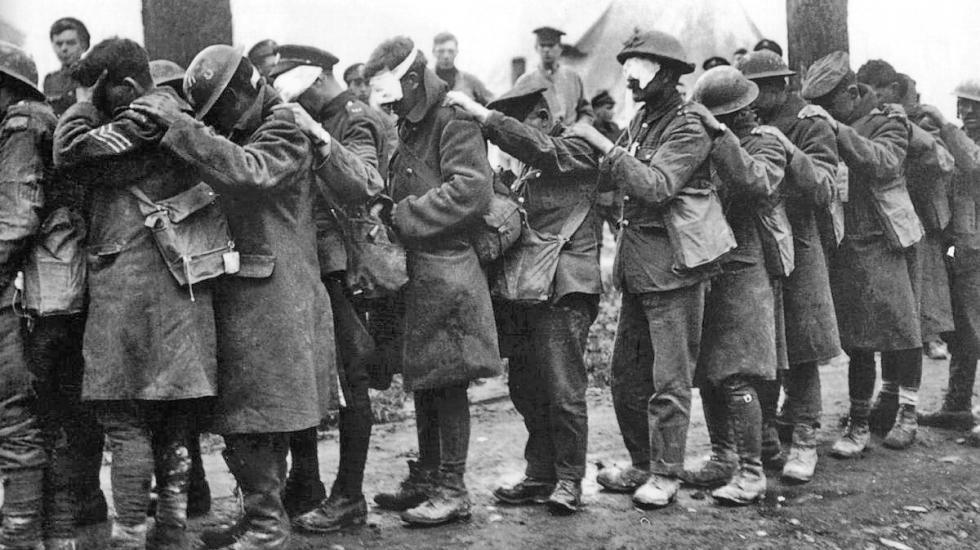
British soldiers blinded by exposure to mustard gas, 1918
Public dismay at the horrors of chemical warfare spurred post-World War I negotiations on a number of instruments meant to prevent its recurrence, most prominently the 1925 Protocol for the Prohibition of the Use of Asphyxiating, Poisonous or Other Gases, and of Bacteriological Methods of Warfare, commonly known as the 1925 Geneva Protocol. The Geneva Protocol does not, however, prohibit the development, production or possession of chemical weapons. It only bans the use of chemical and bacteriological (biological) weapons in war. Furthermore, many countries signed the Protocol with reservations permitting them to use chemical weapons against countries that had not joined the Protocol or to respond in kind if attacked with chemical weapons. In the years since the Geneva Protocol entered into force, some of these States Parties withdrew their reservations and accepted an absolute ban on the use of chemical and biological weapons.
During the first half of the twentieth century, many developed countries spent considerable resources on the development of chemical weapons. Chemical weapons were used by a number of countries in the 1920s and 1930s, and the discovery of powerful nerve gases in the late 1930s renewed interest in the field. All the major powers involved in World War II anticipated that large-scale chemical warfare would take place; however, chemical weapons were never used on European battlefields, for reasons historians still debate. During the Cold War, the United States and the Soviet Union came to maintain enormous stockpiles of tens of thousands of tonnes of chemical weapons.
Chemical Weapons Convention Negotiations
Overshadowed by concerns about nuclear war for much of the post-World War II period, chemical weapons did not receive serious consideration again until 1968, when discussions on biological and chemical weapons started at the Disarmament Conference in Geneva. The treaties to which these debates would eventually lead were arrived at by divergent paths. The Biological Weapons Convention (BWC) was concluded relatively quickly and opened for signature in 1972, although it lacked verification measures. Significantly for subsequent efforts to ban chemical weapons, the BWC obliged its States Parties to continue negotiations on chemical weapons, with the goal of instituting measures mandating their destruction and the prohibition of their development, production and stockpiling.
Negotiations on the Chemical Weapons Convention took much longer, progressing in fits and starts as breakthroughs accompanied political and other changes. In 1980, the Conference on Disarmament established an ad hoc working group on chemical weapons. Four years later, the group was assigned the task of elaborating what a ban on chemical weapons would contain, and thus emerged the provisional, annually updated ‘rolling text’ of the Convention. The improvement in superpower relations in the late 1980s, the chemical attack on Halabja, Iraq in 1988, publicity given to the threat of chemical warfare during the Gulf War, and the announcement of a bilateral United States–Soviet Union agreement to destroy most of their CW stockpiles and to refrain from further CW production all gave impetus to the Convention negotiations.
In spite of advances, a number of issues remained to be ironed out. Some countries wanted chemical disarmament to be linked to progress in nuclear disarmament. Others wanted provisions for assistance in defending against chemical attack. The degree of support the Convention would lend to free trade in chemicals and consequent economic and technological development was a major concern for a large number of countries. Many worried about the intrusiveness of the Convention’s verification regime, particularly its challenge inspections. The United States insisted on retaining the right to retaliate in kind in the event of chemical weapons use until a very late stage of the negotiations. One by one, obstacles were removed and outstanding issues resolved.
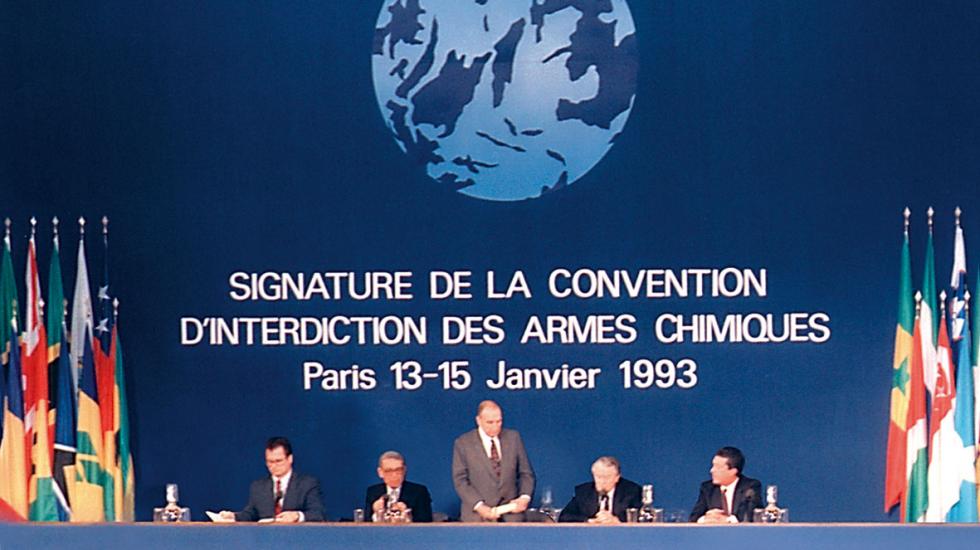
In 1992, a draft Convention was formally adopted by the Conference on Disarmament. The United Nations General Assembly requested that the UN Secretary-General, the depositary of the Convention, opened it for signature on 13 January 1993 in Paris. In an unprecedented show of support for an international arms control treaty, 130 countries signed the Convention during the three-day Paris signing conference.
The OPCW
As provided for in the Convention, the OPCW comprises three main bodies: the Conference of the States Parties, the Executive Council and the Technical Secretariat. All three bodies entered into existence facing imposing work agendas.
The Conference of the States Parties, composed of representatives of all States Parties to the Convention, held its first session beginning on 6 May 1997, one week after entry into force of the CWC.
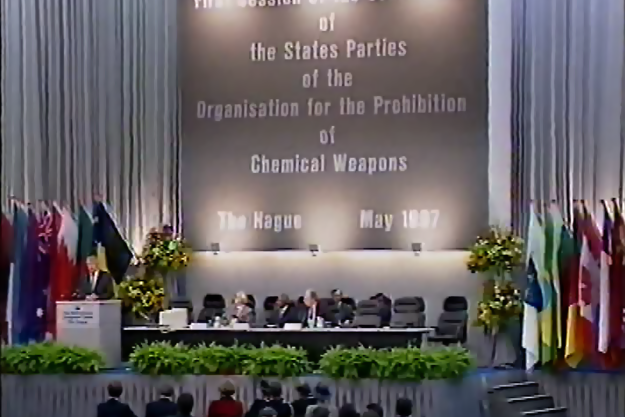
CSP-1
The first Conference of the States Parties convenes on 6 May 1997.
The Conference promptly began the task of considering matters assigned to its jurisdiction by the Convention, various recommendations of the Preparatory Commission, and certain unresolved issues. It elected the members of the Executive Council and appointed José Mauricio Bustani of Brazil to be the OPCW’s first Director-General. Also selected were the members of one of the Organisation’s subsidiary bodies, the Confidentiality Commission. The PrepCom’s recommendations were reflected in many of the Conference’s other decisions. Unresolved issues, it was decided, would be referred to the Committee of the Whole (also consisting of representatives of all States Parties). The Conference continued its work at its second session in December 1997, directing the Director-General to establish a Scientific Advisory Board, considering requests to convert chemical-weapons production facilities, and taking a number of other decisions.
Meanwhile, the Executive Council and the Technical Secretariat started to perform their respective duties. The Council held seven sessions in 1997, at which it considered and approved transitional verification arrangements for chemical-weapons destruction facilities (CWDFs) and facility agreements for plants producing chemicals listed in Schedule 1 of the CWC with potential weapons applications.
The Technical Secretariat began processing initial declarations from States Parties and commenced inspection activities. Out of necessity, early inspections took place primarily at chemical weapons-related facilities, many of which needed to be inspected by specific deadlines to meet the conditions of the Convention. Destruction of chemical weapons required on-site inspections as well. The number of inspections conducted by the OPCW soon numbered in the thousands, and the efficiency with which they were carried out earned the Organisation a reputation for professionalism and impartiality.
In this way, the CWC verification regime began to operate. Declarations related to chemical weapons and production of dual-use chemicals serve to provide baseline data for subsequent confirmation by the Organisation. Inspections are the primary means by which the content of a declaration is verified, taking place at chemical weapons-related facilities and industry facilities. Data from declarations and inspections is disseminated to States Parties in accordance with the Convention’s confidentiality provisions, serving to improve transparency and build confidence in the effectiveness of the regime.
In short, the OPCW is a global, treaty-based international organisation with responsibilities for disarmament and non-proliferation, among others, and with impartial mechanisms necessary to verify compliance and to redress situations of non-compliance, should they occur. In recognition of its extensive efforts to eliminate chemical weapons, the OPCW was awarded the Nobel Peace Prize in 2013.
